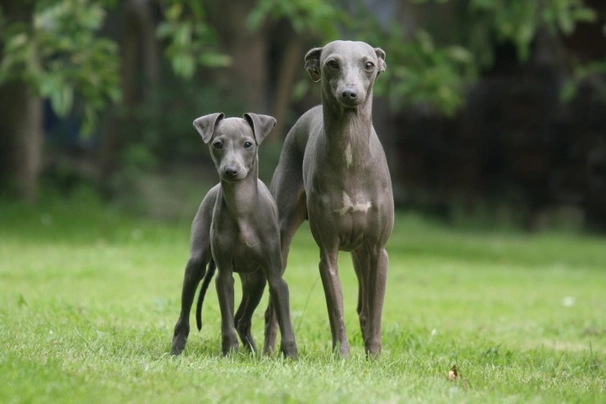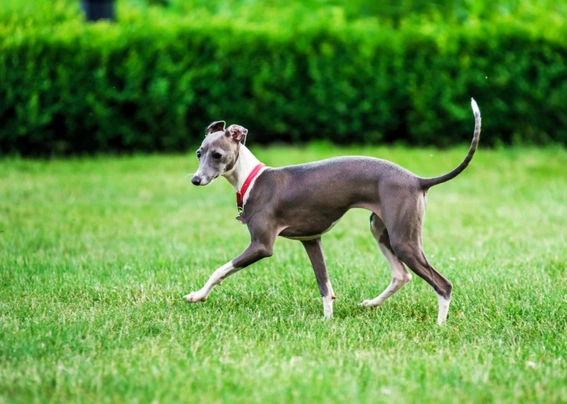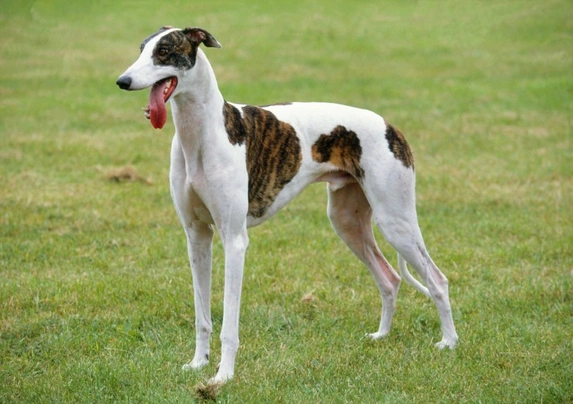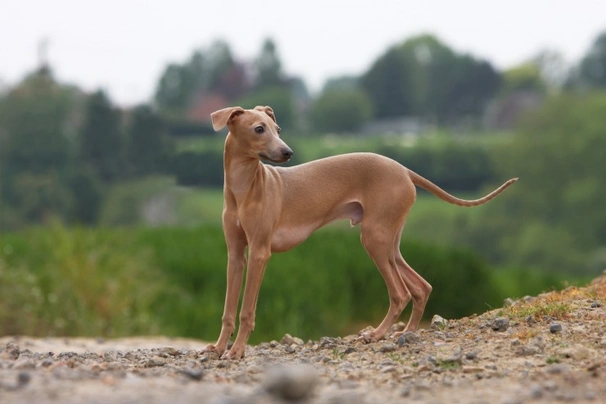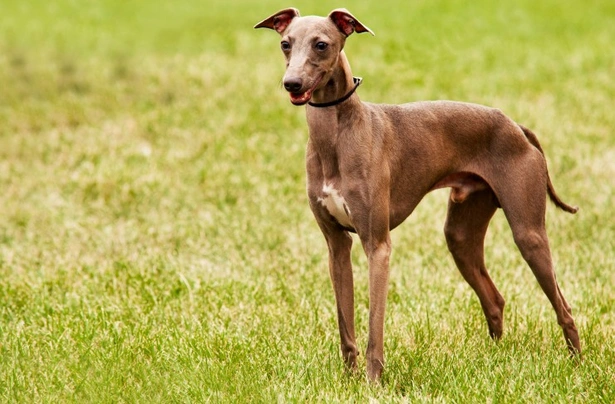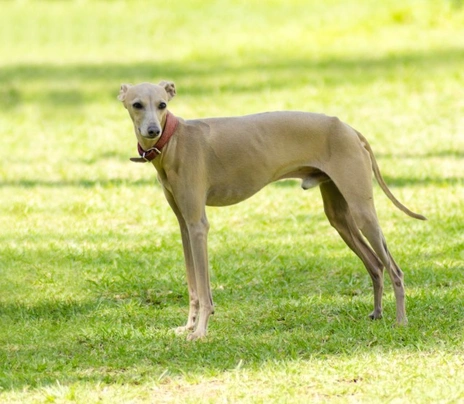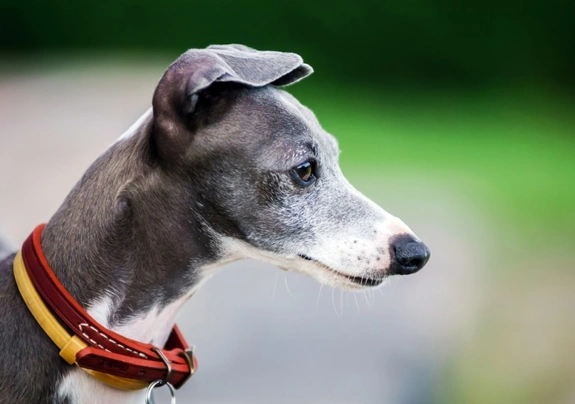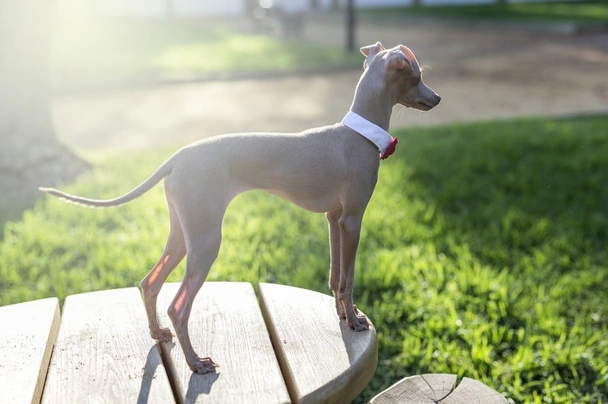Italian Greyhound
Pros
Cons
Introduction of the Italian Greyhound
The Italian Greyhound is the smallest of the "sight" hounds being the diminutive version of their larger Greyhound cousins. They were once the preferred dog of royals and nobility. There are some people who believe the mummified remains of similar dogs that were discovered in ancient Egyptian tombs may well be their ancestors which means the Italian Greyhound could be a descendant of ancient hound-type breeds.
Today the Italian Greyhound remains one of the more popular hound breeds in the UK thanks to their size adaptability and charming looks which when paired to their sweet natures makes them a lovely companion and family pet. However the Italian Greyhound is better suited to households with older children rather than homes with toddlers thanks to their small size and delicate conformation.
History of the Italian Greyhound
The history of the Italian Greyhound remains a bit of a mystery but there are those who believe that the breed has existed for around 2000 years. It was found that similar hound-type dogs were depicted in works of art discovered in archaeological digs both in Turkey and Greece.
On top of this the skeletal remains of small greyhound-type animals found in these regions of the world. There are mummified dogs found in the tombs of Pharaohs in Ancient Egypt and that dogs very much like Italian Greyhounds can be seen in frescoes discovered in Pompeii. Other theories include the fact that Roman centurions took hounds back home with them and kept them as family pets. However all of this has yet to be proved and so the breed's history remains shrouded in the mists of time.
It is thought that Italian type Greyhounds were bred to hunt and to keep vermin under control because they boast being so fast and having such high prey drives. But there is a belief that they were originally bred as companions rather than anything else. It was during the Middle Ages that the breed became popular with many of these hounds being depicted in sculptures and paintings during this period of history. Miniature dogs were held in high esteem by Italians in the Renaissance period and the breed spread further south as its popularity grew throughout the land.
During the 16th and 17th century the hounds were often seen in many courts both in Europe and here in the UK with Mary Queen of Scots and Charles I both owning them. Often depicted by the masters in their paintings the Italian Greyhound although often used to hunt rabbits were in the main really bred as companion dogs. Other royals who were to become breed enthusiasts included Queen Victoria Catherine the Great and Princess Anne of Denmark.
The Italian Greyhound Club of Great Britain was established in 1900 a time when the Italian Greyhound as a breed suffered thanks to unscrupulous breeders attempting to cross them with smaller dogs with an end goal being to create even smaller greyhounds. This led to many dogs suffering from health issues associated with their smaller size. As such the Italian Greyhound Club was set up with an end goal being to encourage breeders to work towards improving the breed.
Fortunately the breed was saved by enthusiasts who through careful and selective breeding managed to rescue these lovely dogs from the brink of extinction. In 2000 the Italian Greyhound Club of Great Britain celebrated its hundredth year and has continued to promote the health and wellbeing of these charming small hounds. Today the Italian Greyhound remains a popular choice as companions and family pets all over the world which includes here in the UK thanks to their charming looks and kind loyal and affectionate natures.
Interesting facts about the breed
- Is the Italian Greyhound a vulnerable breed? No they have consistently remained one of the more popular breeds in the UK and elsewhere in the world
- In Italy noble ladies kept Italian Greyhounds as companions
- Many royals were breed enthusiasts which included Queen Victoria Princess Anne of Denmark and Catherine the Great of Russia
- They are very sensitive to many drugs and anaesthetics
Appearance of the Italian Greyhound
Height at the withers: Males 33 - 38 cm Females 33 - 38 cm
Average weight: Males 3.6 - 8.2 kg Females 3.6 - 8.2 kg
The Italian Greyhound is a smaller version of their larger Greyhound cousins being slender and delicate yet larger than other toy breeds. They have long flat and narrow heads with dogs only having a slight stop. Their muzzles are fine and long with dark coloured noses. They have large eyes with a kind expression in them. Ears are rose shaped and well set back on a dog's head being fine to the touch and which are never pricked. The Italian Greyhound has a strong jaw with a perfect scissor bite where their upper teeth neatly overlap their lower ones. Their necks are long which dogs hold gracefully arched. Shoulders are long and sloping with these fine dogs having straight front legs that are well set under their shoulders.
These little dogs have deep and narrow chests with a nice length to their ribs and brisket. Their backs are slightly arched over their loins and their hindquarters are lean yet powerful with well-muscled thighs and straight strong back legs. Feet are very hare-like in appearance and their tails are set low being long and fine which dogs carry low.
When it comes to their coat the Italian Greyhound boasts a fine short and extremely glossy coat with their skin being supple and fine. The accepted breed colours for Kennel Club registration are as follows:
- Black
- Black & White
- Black White Trim
- Blue
- Blue & Fawn
- Blue & White
- Blue & White Pied
- Blue White Trim
- Cream
- Fawn
- Fawn & White
- Fawn & White Pied
- Fawn White Trim
- Pale Fawn
- Red
- Red & White
- Red White Trim
- White
It is worth noting that Italian Greyhounds with red coats have black tips to each hair thanks to the fact they have a "sable gene" and as such they do not have a "true red coat" like that of a Red Setter.
Gait/movement
When an Italian Greyhound moves they do so with a free high-stepping movement with both their front and back legs moving forward in a straight line showing a good amount of propulsion from their hindquarters.
Faults
The Kennel Club frowns on any exaggerations or departures from the breed standard and would judge the faults on how much they affect a dog's overall health and wellbeing as well as their ability to perform.
Males should have both testicles fully descended into their scrotums and it is worth noting that a dog can be a little lighter or heavier as well as slightly taller or shorter than set out in the Kennel Club breed standard which is given as a guideline only.
Temperament of the Italian Greyhound
The Italian Greyhound is a very good choice as a companion dog and loves nothing more than being in the company of people. However because the breed is so slender and delicate care should be taken when handling them as they can injure easily. A home with older people or no children would be best for IGs because they prefer a quieter and calmer lifestyle. They are highly adaptable by nature and are just at home living in towns as they are in a country environment.
The Italian Greyhound is an athletic albeit fragile and delicate looking dog. They like nothing better than to run "free" in a safe and well enclosed area. However care needs to be taken and dogs should only be allowed to run off their leads where the land is flat and safe for them to do so because Italian Greyhounds boast having fragile bones which can easily break if they run over rough ground.
They tend to be rather aloof and wary of people they do not know but would rarely show any sort of aggressive behaviour towards a stranger preferring to just keep their distance. With this said an IG would soon let an owner know when there are any strangers around. They boast a very strong prey drive and being sight hounds it would be a mistake to let an Italian Greyhound off their leads in areas where they are small animals and livestock.
In a home environment the Italian Greyhound is a loving and affectionate character and they love to snuggle up to their owners whenever they can. They are known to take a little time to bond with an owner but once an IG does the bond remains extremely strong throughout their lives. It cannot be stressed enough the importance of socialising puppies as early as possible in order for an IG to mature into a more outgoing and confident character.
They are very intelligent little dogs and are quick to pick new things up which means both the good and the bad. As such they need to be trained and handled with a firm yet fair and gentle hand to get the best results.
Are they a good choice for first time owners?
Italian Greyhounds are a good choice for first time dog owners because they are so amenable and people-oriented loving nothing more than to please and to entertain the people they have bonded with. They are particularly good with older people too although playtime can get a bit boisterous at times more especially when they are young.
What about prey drive?
Italian Greyhounds have a high prey drive and therefore should not be trusted off the lead anywhere near wildlife or livestock as well as other animals they don't already know. They can get on with cats they have grown up with but care should be taken when they meet any smaller animals and pets which they could see as fair game with disastrous results.
What about playfulness?
Italian Greyhounds have a very playful side to their natures and love to entertain and be entertained. They can turn from being "couch potatoes" into "whirling dervishes" in the blink of an eye when the mood takes them.
What about adaptability?
Italian Greyhounds are highly adaptable and providing they are given enough daily physical exercise combined with as much mental stimulation to prevent boredom from setting in they are just as happy living in an apartment in town as they are living in a house with a secure back garden in the country.
What about separation anxiety?
Italian Greyhounds form strong ties with their families and dogs are never very happy when they find themselves left on their own for longer periods of time. They are better suited to people who either work from home or in households where one person stays at home when everyone else is out so they are never alone for any length of time which could see a dog suffering from separation anxiety. This can lead to them being destructive around the home which is a dog's way of relieving any stress they are feeling and a way to keep themselves entertained.
What about excessive barking?
Italian Greyhounds are not known to be "barkers" and are naturally quiet dogs by natures. This is not to say they would be quick off the mark to let an owner know if something they don't like goes on in their environment.
Do Italian Greyhounds like water?
Italian Greyhounds are not fond of going in the water and are not particularly good swimmers. Anyone who owns a dog that does not like water should never force them to go in because it would just end up scaring them. With this said care should always be taken when walking an Italian Greyhound off the lead anywhere near more dangerous watercourses just in case a dog falls in and then needs rescuing because they can't get out of the water on their own.
Are Italian Greyhounds good watchdogs?
Italian Greyhounds are good watchdogs although they would rarely do this aggressively preferring to alert an owner there are strangers at the door all the while keeping their distance from people they don't already know.
Intelligence / Trainability of the Italian Greyhound
The Italian Greyhound is an intelligent little dog but they often use this to their own advantage to get their own way. They are known to be a little hard to housetrain but with perseverance and a lot of understanding it is possible to teach an IG to do their business outside. Being sight hounds it can be challenging to teach these dogs the "recall" command which is why their training must start early and it must be consistent bearing in mind that even the best trained IG might well ignore to respond to an owner if they have spotted something in the distance they find more interesting.
Italian Greyhounds are very sensitive dogs by nature and as such do not respond well to any sort of harsh correction or heavy-handed training methods. They do answer well to positive reinforcement providing their training is fair and consistent throughout their lives. However it would be a mistake to let an IG off their leads anywhere near livestock or small animals no matter how well trained and responsive they are.
Italian Greyhound puppies are very cute and fragile with it which is why it's so important for a home environment to be made as safe as possible for them. As such puppy-proofing a home well before a new puppy arrives is so important. With this said it is all too easy to spoil a puppy when they first arrive but owners must start out as they mean to go on which means setting out the ground rules right from the word go albeit gently so as not to scare a sensitive little puppy.
- Come
- Sit
- Stay
- Quiet
- Leave it
- Down
- Bed
Children and other
Italian Greyhounds are known to be calm placid dogs by nature. They are very gentle characters rarely showing any sort of aggressive behaviour. However they are not a good choice for people with young families because these little dogs prefer living in a quiet environment because noise tends to stress them out.
They are generally good around other dogs especially if they have been well socialised from a young age. However care must be taken when an Italian Greyhound is anywhere near smaller animals and pets because they will see them as fair game thanks to the breed's high prey drive.
Health of the Italian Greyhound
The average life expectancy of an Italian Greyhound is between 12 and 15 years when properly cared for and fed an appropriate good quality diet to suit their ages.
Like so many other breeds the Italian Greyhound is known to suffer from a few hereditary health issues which are worth knowing about if you are planning share your home with one of these active and good-looking dogs. It is worth noting that currently there are no BVA/KC schemes or DNA tests available for the breed although tests can be carried out by other organisations for hereditary and congenital disorders known to affect an IG. The conditions that seem to affect the breed the most include the following:
- Hereditary cataracts - CERF test available via vet referral
- Progressive retinal atrophy (PRA) - CERF test available test also available through Laboklin and the Animal Health Trust
- Congenital deafness (more especially white coated dogs) - BAER test through the Animal Health Trust
- Von Willebrand’s factor - test available
- Legg-Calve-Perthes disease - dogs can be x-rayed
- Amelogenesis Imperfecta (AI) / Familial Enamel Hypoplasia (FEH) - DNA Test Available
- Epilepsy
- Broken bones
- Polyendocrine syndrome
- Colitis
- Patellar luxation
- Vitreal syneresis of the eye
- Periodontal disease
- Hypothyroidism
- Colour dilution alopecia
- Autoimmune haemolytic anaemia
- Liver shunt
- Corneal dystrophy
- Thrombocytopaenia
More about Epilepsy in the breed
Sadly epilepsy can affect certain Italian Greyhound bloodlines bred in the UK and as such much research is being carried out through the Animal Health Trust and the Italian Greyhound Rescue Charity. Prospective owners should be made aware that healthy dogs do not suffer from any sort of seizure nor should they have any sort of "funny turn" and as such if a breeder says that it is "normal" they are not responsible or reputable breeders and therefore must be avoided.
What about vaccinations?
Italian Greyhound puppies would have been given their initial vaccinations before being sold but it is up to their new owners to make sure they have their follow-up shots in a timely manner with the vaccination schedule for puppies being as follows:
- 10 -12 weeks old bearing in mind that a puppy would not have full protection straight away but would be fully protected 2 weeks after they have had their second vaccination
There has been a lot of discussion about the need for dogs to have boosters. As such it's best to talk to a vet before making a final decision on whether a dog should continue to have annual vaccinations which are known as boosters.
What about spaying and neutering?
A lot of vets these days recommend waiting until dogs are slightly older before spaying and neutering them which means they are more mature before undergoing the procedures. As such they advise neutering males and spaying females when they are between the ages of 6 to 9 months old and sometimes even when a dog is 12 months old.
Other vets recommend spaying and neutering dogs when they are 6 months old but never any earlier unless for medical reasons. With this said many breeds are different and it is always advisable to discuss things with a vet and then follow their advice on when a dog should be spayed or neutered.
What about obesity problems?
Some Italian Greyhounds gain weight after they have been spayed or neutered and it's important to keep an eye on a dog's waistline just in case they do. If a dog starts to put on weight it's important to adjust their daily calorie intake and to up the amount of exercise they are given. Older dogs too are more prone to gaining weight and again it's essential they be fed and exercised accordingly because obesity can shorten a dog's life by several years. The reason being that it puts a lot of extra strain on a dog's internal organs including the heart which could prove fatal.
What about allergies?
Italian Greyhounds are prone to suffering from allergies and it's important for a dog to see a vet sooner rather than later if one flares up more especially as the breed is predisposed to suffering from colour mutant alopecia. Allergies can be notoriously hard to clear up and finding the triggers can be challenging. With this said a vet would be able to make a dog with an allergy more comfortable while they try to find out the triggers which could include the following:
- Certain foods especially commercially produced dog food that contains high levels of grain and cereal fillers
- Airborne pollens
- Dust mites
- Environment
- Flea and tick bites
- Chemicals found in everyday household cleaning products
Participating in health schemes
All responsible Italian Greyhound breeders would ensure that their stud dogs are tested for known hereditary and congenital health issues known to affect the breed by using the following schemes bearing in mind that there are no DNA tests or other screening available through a BVA/KC scheme:
- Hereditary cataracts - CERF test available via vet referral
- Progressive retinal atrophy (PRA) - CERF test available test also available through Laboklin and the Animal Health Trust
- Testing for Von Willebrand’s factor
- X-ray examination for Legg-Calve-Perthes disease
What about breed specific breeding restrictions?
Apart from the standard breed restrictions set in place for all Kennel Club registered breeds there are no other breed specific breeding restrictions for the Italian Greyhound.
What about Assured Breeder Requirements?
Currently there are no KC Assured Breeder requirements for the Italian Greyhound but prospective owners should ask breeders about health issues and tests relevant to the breed before buying an IG puppy from them.
Caring for the Italian Greyhound
As with any other breed Italian Greyhounds need to be groomed on a regular basis to make sure their coats and skin are kept in top condition. They also need to be given regular daily exercise to ensure they remain fit and healthy. On top of this dogs need to be fed good quality food that meets all their nutritional needs throughout their lives.
Caring for an Italian Greyhound puppy
Italian Greyhound puppies are boisterous and full of life which means it's essential for homes and gardens to be puppy-proofed well in advance of their arrival. A responsible breeder would have well socialised their puppies which always leads to more outgoing confident and friendly dogs right from the word go. With this said any puppy is going to feel vulnerable when they leave their mother and littermates which must be taken into account. The longer a puppy can remain with their mother the better although it should never be for too long either.
It's best to pick a puppy up when people are going to be around for the first week or so which is the time needed for a puppy to settle in. Puppy-proofing the home and garden means putting away any tools and other implements that a boisterous puppy might injure themselves on. Electric wires and cables must be put out of their reach because puppies love chewing on things. Toxic plants should be removed from flowerbeds and the home too.
Puppies need to sleep a lot to grow and develop as they should which means setting up a quiet area that's not too out of the way means they can retreat to it when they want to nap and it's important not to disturb them when they are sleeping. It's also a good idea to keep "playtime" nice and calm inside the house and to have a more active "playtime" outside in the garden which means puppies quickly learn to be less boisterous when they are inside.
The documentation a breeder provides for a puppy must have all the details of their worming date and the product used as well as the information relating to their microchip. It is essential for puppies to be wormed again keeping to a schedule which is as follows:
- Puppies should be wormed at 6 months old
- They need to be wormed again when they are 8 months old
- Puppies should be wormed when they are 10 months old
- They need to be wormed when they are 12 months old
Things you'll need for your puppy
There are certain items that new owners need to already have in the home prior to bringing a new puppy home. It's often a good idea to restrict how much space a puppy plays in more especially when you can't keep an eye on what they get up to bearing in mind that puppies are often quite boisterous which means investing in puppy gates or a large enough playpen that allows an Italian Greyhound puppy the room to express themselves while keeping them safe too. The items needed are therefore as follows:
- Good quality puppy or baby gates to fit on doors
- A good well-made playpen that's large enough for a puppy to play in so they can really express themselves as puppies like to do
- Lots of well-made toys which must include good quality chews suitable for puppies to gnaw on bearing in mind that a puppy will start teething anything from when they are 3 to 8 months old
- Good quality feed and water bowls which ideally should be ceramic rather than plastic or metal
- A grooming glove
- A slicker brush or soft bristle brush
- Dog specific toothpaste and a toothbrush
- Scissors with rounded ends
- Nail clippers
- Puppy shampoo and conditioner which must be specifically formulated for use on dogs
- A well-made dog collar or harness
- A couple of strong dog leads
- A well-made dog bed that's not too small or too big
- A well-made dog crate for use in the car and in the home that's large enough for a puppy to move around in
- Baby blankets to put in your puppy's crate and in their beds for when they want to nap or go to sleep at night
Keeping the noise down
All puppies are sensitive to noise including Italian Greyhound puppies bearing in mind that these fragile dogs are ultra-sensitive by nature. It's important to keep the noise levels down when a new puppy arrives in the home. TVs and music should not be played too loud which could end up stressing a small puppy out.
Keeping vet appointments
As previously mentioned Italian Greyhound puppies would have been given their first vaccinations by the breeders but they must have their follow up shots which is up to their new owners to organise. The vaccination schedule for puppies is as follows:
- 10 -12 weeks old bearing in mind that a puppy would not have full protection straight away but would only be fully protected 2 weeks after they have had their second vaccination
When it comes to boosters it's best to discuss these with a vet because there is a lot of debate about whether a dog really needs them after a certain time. However if a dog ever needed to go into kennels their vaccinations would need to be
What about older Italian Greyhounds when they reach their senior years?
Older Italian Greyhounds need lots of special care because as they reach their golden years they are more at risk of developing certain health concerns. Physically a dog's muzzle may start to go grey but there will be other noticeable changes too which includes the following:
- Coats become coarser
- A loss of muscle tone
- Italian Greyhounds can either become overweight or underweight
- They have reduced strength and stamina
- Older dogs have difficulty regulating their body temperature
- They often develop arthritis
- Immune systems do not work as efficiently as they once did which means dogs are more susceptible to infections
Older dogs change mentally too which means their response time tends to be slower as such they develop the following:
- They respond less to external stimuli due to impaired vision or hearing
- They tend to be a little pickier about their food
- They have a lower pain threshold
- Become intolerant of any change
- Often an older dog can feel disorientated
Living with an Italian Greyhound in their golden years means taking on a few more responsibilities but these are easily managed and should include looking at their diet the amount of exercise they are given how often their dog beds need changing and keeping an eye on the condition of their teeth.
Older Italian Greyhounds need to be fed a good quality diet that meets their needs at this stage of their lives all the while keeping a close eye on a dog's weight. A rough feeding guide for older dogs is as follows bearing in mind they should be fed highly digestible food that does not contain any additives:
- Protein content should be anything from 14 – 21%
- Fat content should be less than 10%
- Fibre content should be less than 4%
- Calcium content should be 0.5 – 0.8%
- Phosphorous content should be 0.4 – 0.7%
- Sodium content should be 0.2 – 0.4%
Older Italian Greyhounds don't need to be given the same amount of daily exercise as a younger dog but they still need the right amount of physical activity to maintain muscle tone and to prevent a dog from putting on too much weight. All dogs need access to fresh clean water and this is especially true of older dogs when they reach their golden years because they are more at risk of developing kidney disorders.
Grooming of the Italian Greyhound
Italian Greyhounds are low maintenance when it comes to keeping their coats tidy and their skin in good condition thanks to their coats being so short. However it is best to give them a brush at least twice a week as this allows you to check for injuries and skin issues that may be flaring up. They do shed throughout the year but like other breeds they tend to shed more during the Spring and then again in the Autumn when more frequent brushing may be necessary to keep on top of things.
They are known to suffer from quite a few dental issues as such it's important for dogs to have their teeth cleaned and checked on a regular basis. It's also important to check a dog's ears on a regular basis and to clean them when necessary. If too much wax builds up in a dog's ears it can lead to a painful infection which can be hard to clear up. In short prevention is often easier than cure when it comes to ear infections.
Exercise of the Italian Greyhound
Although small in stature the IG needs to be given the right amount of physical exercise every day for them to be truly happy well-rounded and healthy dogs. As such they need at least 40 to 60 minutes a day. A shorter walk in the morning would be fine but a longer more interesting one in the afternoon is a must. Halters and leads work best on the delicate IG as they spread the pressure across a dog's chest and shoulders rather than around their necks.
These dogs also like to be able to roam around a back garden as often as possible so they can really let off steam. However the fencing must be extremely secure to keep these lively and athletic little dogs in because if they find a weakness in the fence they will soon escape out and get into all sorts of trouble.
With this said IG puppies should not be given too much exercise because their joints and bones are very fragile and too much pressure on them could result in a dog breaking one. They should not be allowed to jump up or off furniture nor should they be allowed to run up and down the stairs because this puts too much pressure on their still growing joints and could end up with an IG breaking a bone.
Feeding of the Italian Greyhound
If you get an Italian Greyhound puppy from a breeder they would give you a feeding schedule and it's important to stick to the same routine feeding the same puppy food to avoid any tummy upsets. You can change a puppy's diet but this needs to be done very gradually always making sure they don't develop any digestive upsets and if they do it's best to put them back on their original diet and to discuss things with the vet before attempting to change it again. It's also important that puppies be fed frequently throughout the day because they are susceptible to developing hypoglycemia.
Older dogs are not known to be fussy or finicky eaters but this does not mean you can feed them a lower quality diet. It's best to feed a mature dog twice a day once in the morning and then again in the evening making sure it's good quality food that meets all their nutritional requirements. It's also important that dogs be given the right amount of exercise so they burn off any excess calories or they might gain too much weight which can lead to all sorts of health issues. Obesity can shorten a dog's life by several years so it's important to keep an eye on their waistline from the word go.
Feeding guide for an Italian Greyhound puppy
Puppies need to be fed a highly nutritious good quality diet for them to develop and grow as they should. As a rough guide an Italian Greyhound puppy can be fed the following amounts every day making sure their meals are evenly spread out throughout the day and it's best to feed them 3 or 4 times a day:
- 2 months old - 63g to 156g depending on puppy's build
- 3 months old - 71g to 164g depending on puppy's build
- 4 months old - 75g to 184g depending on puppy's build
- 5 months old - 75g to 184g depending on puppy's build
- 6 months old - 68g to 168g depending on puppy's build
- 7 months old - 61g to 160g depending on puppy's build
- 8 months old - 54g to 132g depending on puppy's build
- 9 months old - 53g to 132g depending on puppy's build
- 10 months old - 53g to 130g depending on puppy's build
Once a puppy is 11 months old they can be fed adult dog food.
Feeding guide for an adult Italian Greyhound
Once fully mature an adult Italian Greyhound must be fed a good quality diet to ensure their continued good health. As a rough guide an adult Italian Greyhound can be fed the following amounts every day:
- Dogs weighing 3.6 kg can be fed g to g depending on activity
- Dogs weighing 4 kg can be fed g to g depending on activity
- Dogs weighing 5 kg can be fed 80g to 93g depending on activity
- Dogs weighing 6 kg can be fed 92g to 106g depending on activity
- Dogs weighing 7 kg can be fed 103g to 119g depending on activity
- Dogs weighing 8 kg can be fed 114g to 132g depending on activity
Italian Greyhound price
If you are looking to buy an Italian Greyhound you would need to pay anything from £700 to over £1000 for a well-bred pedigree puppy. The cost of insuring a male 3-year-old Italian Greyhound in northern England would be £22.51 a month for basic cover but for a lifetime policy this would set you back £42.76 a month (quote as of February 2018). When insurance companies calculate a pet's premium they factor in several things which includes where you live in the UK and a dog's age and whether they have been neutered or spayed.
When it comes to food costs you need to buy the best quality food whether wet or dry to feed your dog throughout their lives making sure it suits the different stages of their lives. This would set you back between £20 - £30 a month. On top of this you would need to factor in veterinary costs if you want to share your home with an Italian Greyhound and this includes their initial vaccinations their annual boosters the cost of neutering or spaying your dog when the time is right and their yearly health checks all of which quickly adds up to over a £900 a year.
As a rough guide the average cost to keep and care for an Italian Greyhound would be between £50 to £80 a month depending on the level of insurance cover you opt to buy for your dog but this does not include the initial cost of buying a well-bred healthy Kennel Club registered pedigree Italian Greyhound puppy.
Buying advice
When visiting and buying any puppy or dog there are many important things to consider and questions to ask of the breeder/seller. You can read our generic puppy/dog advice here which includes making sure you see the puppy with its mother and to verify that the dog has been wormed and microchipped.
Italian Greyhounds are among some of the more popular breeds both in the UK and elsewhere in the world which means that well-bred puppies can often command a lot of money. As such with Italian Greyhounds there is specific advice questions and protocols to follow when buying a puppy which are as follows:
- Beware of online scams and how to avoid them. You may see online and other adverts by scammers showing images of beautiful Italian Greyhoundpuppies for sale at very low prices. However the sellers ask buyers for money up front before agreeing to deliver a puppy to a new home. Potential buyers should never buy a puppy unseen and should never pay a deposit or any other money online to a seller. You should always visit the pet at the sellers home to confirm they are genuine and make a note of their address.
- As previously touched upon Italian Greyhounds are among the most popular breeds in the UK. As such there are many amateur breeders/people who breed from a dam far too often so they can make a quick profit without caring for the welfare of the puppies their dam or the breed in general. Under Kennel Club rules a dam can only produce 4 litters and she must be between a certain age to do so. Anyone wishing to buy an Italian Greyhound puppy should think very carefully about who they purchase their puppy from and should always ask to see the relevant paperwork pertaining to a puppy's lineage their vaccinations and their microchipping.
- Prospective owners should be very careful when considering buying an extra small puppy because all too often they suffer from very serious health issues and no responsible breeder would purposefully breed dogs so they are too small.
